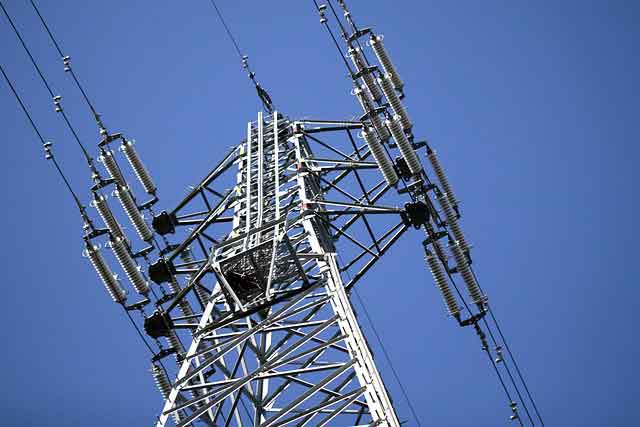Power grid beats heat: But record demand exposes how region is being deprived of cheaper electricity
MARYLAND - The region's power grid held up despite record demand for electricity along the Eastern Seaboard July 18, but energy experts say the heat wave has stressed the system and highlighted the need for investment in new transmission lines to keep prices down and ensure reliability.
The PJM Interconnection, which operates the electric grid for 51 million people in Maryland and 12 other states, said peak demand in the power pool reached about 134,721 megawatts July 18, down slightly from the previous day's record of 139,746 megawatts. Each megawatt is enough electricity to supply 800 to 1,000 homes.
Grid operators called on consumers to conserve, and utility officials throughout the Baltimore region sent extra crews into the field to monitor circuits and substations to keep equipment from becoming overloaded.
Some large manufacturers, office buildings and hospitals voluntarily curtailed power usage in keeping with contractual agreements that entitled them to reduced electric rates in exchange for agreeing to cut back during hot weather.
The heightened concern of power grid operators was felt nationwide as scorching temperatures blanketed the country and set electrical consumption records in many heavily populated areas.
"It's days like today that really stress the electric system across the country," said Mark P. Huston, vice president of electric transmission and distribution for the Baltimore Gas and Electric Co.
The problem is especially acute in the Baltimore-Washington region, where grid operators say new transmission lines are desperately needed to bring more and cheaper power to the region from the West.
The PJM is studying as much as $10 billion in new transmission line proposals to help alleviate congestion throughout the system. Those investments, power grid officials say, could save $1 billion a year in congestion-related electricity costs. The projects would be initiated and financed by utilities and ratepayers in the region.
The shortcomings of the system were on display yesterday as prices in the spot market for power in the Baltimore region briefly soared to slightly more than $800 per megawatt - almost 13 times the weighted average price per megawatt in PJM territory for all of 2005.
The spike occurred because power suppliers were forced to turn on more expensive gas-powered generating units to meet rising demand. Because of the transmission line shortfall, BGE was unable to tap into cheap electricity available in abundance from plants west of Maryland in states such as West Virginia, Ohio and others.
"It's lower-cost power that could be serving the (Baltimore) area if there was just a good way to get it there," said Ray Dotter, a spokesman for PJM.
Lack of transmission line capacity contributed to problems BGE had during a similar heat wave a year ago, when the utility was forced to reduce voltage on its lines because of stress on the system. Since then, the utility has installed additional equipment - called capacitors - that help increase the flow of electricity over power lines during times of peak demand.
"We make heavy investments to ensure the system operates as intended in a safe, reliable fashion," said Rob Gould, a spokesman for the utility.
The peak power daily demand reached in PJM territory July 17 and 18 shattered the previous record of 133,763 megawatts set last July.
To put that in perspective, the July 17 peak beat the old record by nearly the same number of megawatts as is used on an average day by all of BGE's 1.2 million residential and industrial customers.
Though there are regional transmission bottlenecks, the PJM power pool actually has more than enough generating capacity to meet demand during a heat wave.
Power companies operating within the pool have capacity to produce up to 165,000 megawatts of power - or roughly 25,000 more than the July 17 record demand. Problems develop when there isn't enough capacity in distribution lines to carry all of the load being generated.
"It does highlight the benefits of adding additional major power lines, which we have under study right now," Dotter said.
To help ward off problems, PJM called on utility customers in Eastern states to take steps to conserve energy - especially between the hours of 3 p.m. and 7 p.m., when most people go home and crank up their air conditioners.
BGE took steps to intermittently shut off air conditioners and water heaters in about 225,000 local homes as part of a program to save energy during times of peak demand. Those customers - about 20 percent of the utility's total households - agreed to let the utility install remote control devices on certain appliances in exchange for cheaper rates.
When usage reaches high levels, BGE cycles the units on and off about every 15 minutes. Most customers notice little difference, said Andy Dodge, BGE's director of system operations.
With the expectation of cooler temperatures today and the rest of the week, operators late last night canceled requests that consumers make heightened efforts to conserve energy.
But BGE customers have an added reason to conserve. Legislation passed in special session last month allowed BGE's residential customers to defer most of a 72 percent rate increase that was set to take effect July 1.
Ratepayers instead received a 15 percent rate increase for 11 months, after which they will have to start paying back the deferred amount through a surcharge that will be added to bills for the next 10 years.
The size of the monthly charge - estimated to average $2.19 per customer - will vary depending on each household's usage. That means the more electricity customers use this summer, the higher the fee that will be added to their bills for the next decade.
Related News

Germany launches second wind-solar tender
BERLIN - Germany's Federal Network Agency (BNA) has launched its second joint onshore wind and solar photovoltaic (PV) tender, with a total capacity of 200 MW.
A maximum guaranteed subsidy payment has been set at 87.50 per MWh for both energy sources, which BNA says will have to compete against each other for the lowest price of electricity. According to auction rules, all projects must have a minimum of 750 kW.
The auction is due to be completed on 2 November.
The network regulator has capped solar projects at 10 MW, though this has been extended to 20 MW in some districts. Onshore wind…




